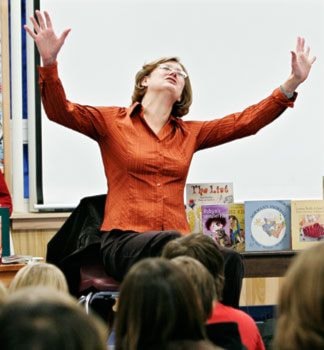A small army of children’s authors, illustrators and storytellers were drawn into Canadian schools and libraries last week.
They were part of a national effort by the Toronto-based Canadian Children’s Book Centre to get young Canadians “enthusiastic” about reading.
“Tell me something you find interesting about Whitehorse because I’ve never been here before!” said author Hazel Hutchins vivaciously, extending her arms into the air as children filed into the multipurpose room at Christ the King Elementary School on Wednesday for her presentation.
“The (unintelligible) shut down,” said a student.
“It didn’t have enough money,” chimed in another.
“Oh, bankruptcy,” said Hutchins.
Beating out “lots” of other authors who had been clamouring to visit the North for Book Week, Hutchins visited elementary schools throughout Whitehorse and the communities.
“I had to fill out a stack of papers this thick,” she said to the students, holding her hands apart to indicate the lengthy Book Week registration process.
Hutchins described her storytelling origins as coming from a solitary childhood.
“I invented two imaginary friends with the unlikely names of Juty and Barrette. They were very good company, always played the exact games I wanted to play and never, ever went away in a huff,” writes Hutchins on her website.
“By Grade 5, I knew I wanted to be a writer and I used to sneak off and write poems and stories alone,” Hutchins told the crowd.
By high school, Hutchins was attempting to write professionally, but initial submissions all came back with rejection letters; “little slips of paper that make you feel awful,” she said.
“Any questions?”
Silence.
“Good, I hate questions, you don’t know what a relief that is,” she said jokingly.
One of Hutchin’s most recent books, TJ and the Quiz Kids, follows TJ in his fourth novel as he competes against a rival school in a televised quiz show.
The book is delightfully spiced with a variety of bizarre quiz tidbits.
“For every human there are 200,000 insects,” read Hutchins.
The ingredient that makes lipstick shine is made out of fish scales.
“The capital of China is … ?” asked Hutchins.
“Beijing,” answered the crowd.
“What are the similarities between jellyfish and cat urine?” she asked.
This time the audience had no response, aside from the suggestion that they were both ‘gross.’
“They both glow under a black light,” said Hutchins.
Mattland follows a child who hates his new neighbourhood, but by tracing rivers into the mud, gradually builds a better perspective of his surroundings.
“When you’re really mad, everything looks ‘yuck,’ but that goes away when you cheer up,” she said.
Hutchins has more than 20 children’s picture books and novels to her name, and has a host of awards.
Tess, published in 1994, received the Storytelling World Award, was shortlisted for the Governor General children’s literature award and the Mr. Christie’s book award.
Coming from tiny Canmore, Alberta, yet having her books published all over the world, Hutchins was able to assure the audience members that even though they live in a small town, the wider world is not so far away.
“You don’t have to move to New York or Los Angeles to be part of things that happen all over the world,” she said.
Three quarters of the way into the presentation, the students were told to stand up and take a break from sitting on the hard floor.
Hutchins clapped a cadence, and the students unflinchingly responded with a replica sequence of claps.
She did the same with a series of foot-stamping cadences.
“It’s a little scary but that stamping part gave me this uncomfortable surge of power — have you ever seen movies of military dictatorships?” she asked.
Most of the children nodded, ‘yes.’
“That’s what life does, it gives you little things like that and it’s really interesting,” said Hutchins.
Hutchins led students further into the mental processes that inspire her books.
When her children were young, they had a game where they would continually snare her in a lasso. She demonstrated by gently throwing a rope around one of the students.
“Uh oh, what’s going to happen?” he said, playing for the crowd.
The “trap” idea became the basis of her 1987 book, Leanna Builds a Genie Trap.
At a past school presentation, after pulling out the rope and asking children if they knew what it was, a student had earnestly responded, “a shoelace.”
Not wanting to embarrass the student, Hutchins played along — and another story idea was soon born.
“Stories are about problems and if you have a shoelace this big, you have a problem,” she said.
The result was a story about a traveller that finds a rope and dinner plate, only to realize that it was the lost shoelace and shirt button of a baby giant.
“Sometimes the strange ideas you get are the best ideas of all,” she said.
One time, while she sat in bed, she imagined the room around her morphing into a 19th-century tableau. She jotted down the idea, and five years later it became a book.
Just as Wade Davis immersed himself in zombie-related ethnobotany before writing The Serpent and the Rainbow, so too did Hazel Hutchins take up juggling before writing a story about an invisible child who juggles.
To demonstrate, she took out three hacky sacks and began juggling, first with one hand, and then with both — an impressive feat for someone who has a binocular deficiency.
“Because I tried it myself I could write it a thousand times better,” she said, the balls cascading through the air in front of her face.
“Any questions?” asked Hutchins at the end of the one-hour presentation.
“How long have you been juggling?” asked one student.
“Where did you get the (juggling) balls?” asked another.
Contact Tristin Hopper at tristinh@yukon-news.com
